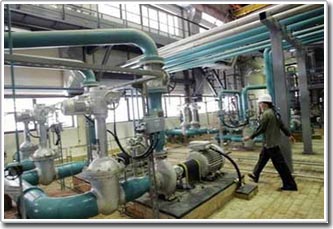Iran tested high-speed uranium enrichment
Iran has developed a new generation of advanced centrifuges for enriching uranium at a faster rate than its predecessors, diplomats and experts said Feb. 7.
They say Iran is operating this type of IR-2 centrifuge and the testing process seems to be in the early stages because new machines are running without processing uranium. More importantly, Iran has used the know-how and equipment acquired in the black market, combined with domestic intelligence, to overcome technical difficulties and manufacture advanced centrifuges.
The Iranian enrichment of uranium has prompted the United States and Western countries to worry that the program could produce radioactive materials needed for nuclear bombs. However, Tehran said it only enriched uranium at low levels to get fuel for nuclear power reactors.

A Russian expert inside Iran's Bushehr nuclear power plant (Photo: VNN)
Iran is under two UN sanctions sanctions for refusing to stop uranium enrichment. Iran started this program for nearly two decades conducting secret nuclear activities. That secret was revealed five years ago and raised doubts about Iran's nuclear intentions. Iranian leaders say Iran has the right to conduct a peaceful uranium enrichment program and rejects the UN's request, saying it will expand the program.
Until recent weeks, Iran has publicly focused on the obsolete P1 centrifuges it bought in the black market in the 1980s. Specifically, Iran has installed more than 3,000 of these machines in the country. Underground facility near Natanz - a city about 480km south of Tehran. According to diplomats, Iranian experts are now testing some of the more advanced IR-2 machines. They describe this as a hybrid device from the P2 centrifuge ever sold on the black market by AQKhan - a scientist who oversees Pakistan's nuclear weapons development program.
The P2 that Khan sold can enrich uranium gas three times faster than P1 but made from low carbon and high nickel steel . It is difficult to produce and smuggle this type of steel due to strict international control. One of the diplomats said Iran had overcome this obstacle by using carbon fiber to produce centrifugal rotor tubes. Machinery and technology to produce this machine were taken from Iran's missile manufacturing industry. According to former UN inspector, David Albright, 1,200 IR-2 centrifuges within a year can produce enough fuel for a nuclear warhead, compared to 3,000 P1s.
Over the years, Iran has refused to provide details about the country's centrifugal development program to the International Atomic Energy Agency (IAEA). However, in recent months, the country has expressed its willingness to cooperate and pledges to clarify all past nuclear activities. Last month, Iran gave the IAEA Director a document about the new generation of centrifuges during talks in Tehran. ElBaradei will report on the IAEA's investigation progress before the agency's 35-member council next month.
- Iran is testing a new modern uranium enrichment machine
- Uranium enrichment: Death technology
- Iran has increased its intensity to triple uranium enrichment
- Iran built a new generation uranium enrichment centrifuge
- Iran moved nuclear devices to the ground
- Iran will install new centrifuges at the uranium 2 facility
- Concerns increase with US uranium enrichment plans
- Rich uranium is about to dock in Iran
- Iran expanded its nuclear program
- Can exploit uranium from seawater?
- Vietnam pays nuclear fuel to Russia
- Iran announces the feat of nuclear technology
 Vietnam 5th Asian champion on fuel-efficient vehicles
Vietnam 5th Asian champion on fuel-efficient vehicles We can read all NASA studies completely free of charge
We can read all NASA studies completely free of charge Singer and songwriter Bob Dylan won the 2016 Nobel Prize for Literature
Singer and songwriter Bob Dylan won the 2016 Nobel Prize for Literature Scientific revolution in Asia
Scientific revolution in Asia